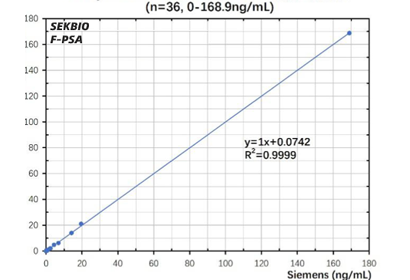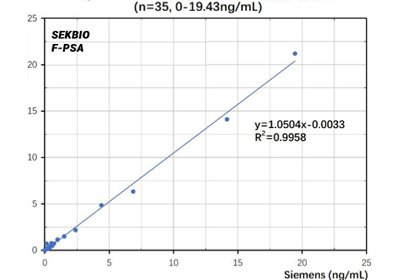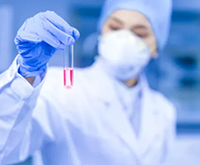Prostate-Specific Antigen (PSA Tumor Marker)
Prostate-specific antigen (PSA specific antigen), also known as gamma-selenoprotein or kallikrein-3, is a glycoprotein enzyme encoded in humans by the KLK3 gene. PSA is a member of the kallikrein-related peptidase family and is secreted by the epithelial cells of the prostate gland.
The PSA tumour marker test can detect high levels of PSA that may indicate the presence of prostate cancer. However, many other conditions, such as an enlarged or inflamed prostate, can also increase PSA levels. Therefore, determining what a high PSA score means can be complicated.
SEKBIO now offers Mouse anti-human PSA mAb, Humanized anti-human PSA mAb, Mouse anti-human free PSA mAb, and Prostate-Specific Antigen (Eukaryotic expression).
The performance data of the PSA Rapid Quantitative Test Kit (FIA)
Manufacturer | SEKBIO |
Parameter | PSA Rapid Quantitative Test Kit (FIA) |
Linearity | 2~80ng/mL |
Detection limit | 2ng/mL |
Benchmark product | Roche |
1 Limit of detection
Result(T/C) | Concentration | |
0 | 1.89 | |
1 | 0.01023 | 0.73546 |
2 | 0.01204 | 0.71584 |
3 | 0.01497 | 0.71923 |
4 | 0.00979 | 0.60017 |
5 | 0.01071 | 0.61771 |
6 | 0.01378 | 0.67404 |
7 | 0.01473 | 0.66088 |
8 | 0.01390 | 0.61598 |
9 | 0.01098 | 0.55827 |
10 | 0.01118 | 0.71461 |
11 | 0.01511 | 0.64823 |
12 | 0.00995 | 0.60619 |
13 | 0.01229 | 0.61861 |
14 | 0.01183 | 0.71555 |
15 | 0.01268 | 0.58376 |
16 | 0.01402 | 0.67005 |
17 | 0.01413 | 0.73904 |
18 | 0.01173 | 0.56993 |
19 | 0.01535 | 0.73439 |
20 | 0.01222 | 0.62362 |
AVE | 0.01258 | 0.65608 |
SD | 0.00181 | / |
AVE+2*SD | 0.01620 | / |
regression equation | y=0.34047x+0.01258 | |
LoB(ng/mL) | 0.01062 | |
2 Linear
Cal | Concentration | Result | AVERAGE |
S1 | 1.89 | 1.85 | 1.92 |
2.04 | |||
1.86 | |||
S2 | 4.25 | 3.77 | 3.87 |
4.01 | |||
3.84 | |||
S3 | 15.79 | 15.33 | 16.27 |
16.63 | |||
16.86 | |||
S4 | 47.98 | 50.56 | 50.31 |
56.60 | |||
43.76 | |||
S5 | 75.46 | 74.26 | 75.28 |
81.33 | |||
70.26 | |||
S6 | 102.78 | 101.29 | 96.31 |
94.08 | |||
93.56 |

3 Accuracy
Cal | concentration | Result | Bias |
A1 | 4.25 | 4.51 | 6.1% |
4.67 | 9.8% | ||
4.50 | 5.8% | ||
A2 | 15.79 | 17.14 | 8.5% |
15.92 | 0.8% | ||
15.14 | -4.1% | ||
A3 | 47.98 | 44.01 | -8.3% |
44.84 | -6.5% | ||
47.72 | -0.5% |
4 Precision
Cal | Concentration | Cal | Concentration | Cal | Concentration |
R1 | 4.07 | R2 | 14.53 | R3 | 50.93 |
3.73 | 17.90 | 41.13 | |||
3.90 | 13.59 | 41.15 | |||
4.75 | 17.64 | 51.21 | |||
4.79 | 14.67 | 47.59 | |||
4.55 | 16.76 | 48.88 | |||
3.76 | 16.09 | 41.74 | |||
4.20 | 16.25 | 41.56 | |||
4.62 | 17.52 | 46.51 | |||
3.91 | 13.91 | 46.01 | |||
AVE | 4.23 | AVE | 15.89 | AVE | 45.67 |
SD | 0.41 | SD | 1.61 | SD | 4.03 |
CV | 9.8% | CV | 10.1% | CV | 8.8% |
5 Method Comparison

Sample | Roche | Sekbio | Sample | Roche | Sekbio |
1 | 59.42 | 61.41 | 31 | 49.03 | 43.41 |
2 | 83.66 | 79.24 | 32 | 48.66 | 55.35 |
3 | 28.09 | 27.43 | 33 | 9.07 | 8.86 |
4 | 85.56 | 81.42 | 34 | 75.18 | 83.15 |
5 | 6.30 | 7.43 | 35 | 57.01 | 61.40 |
6 | 5.46 | 5.05 | 36 | 2.76 | 2.50 |
7 | 3.21 | 3.39 | 37 | 41.39 | 42.21 |
8 | 6.05 | 6.13 | 38 | 14.57 | 14.12 |
9 | 16.92 | 19.46 | 39 | 15.08 | 16.81 |
10 | 41.94 | 44.12 | 40 | 12.39 | 10.92 |
11 | 13.53 | 13.95 | 41 | 30.37 | 31.25 |
12 | 9.72 | 10.21 | 42 | 80.36 | 83.40 |
13 | 31.93 | 35.34 | 43 | 3.62 | 3.47 |
14 | 2.92 | 2.64 | 44 | 82.33 | 77.91 |
15 | 59.37 | 70.56 | 45 | 49.81 | 52.44 |
16 | 80.24 | 73.92 | 46 | 11.45 | 10.75 |
17 | 92.83 | 86.71 | 47 | 10.71 | 10.60 |
18 | 50.50 | 57.53 | 48 | 59.50 | 54.21 |
19 | 39.66 | 41.91 | 49 | 13.13 | 11.96 |
20 | 2.84 | 3.01 | 50 | 3.37 | 3.72 |
21 | 36.08 | 40.05 | 51 | 5.54 | 4.65 |
22 | 75.87 | 71.99 | 52 | 83.72 | 90.20 |
23 | 24.68 | 24.47 | 53 | 9.52 | 11.24 |
24 | 4.97 | 4.10 | 54 | 8.41 | 9.24 |
25 | 2.11 | 2.38 | 55 | 82.06 | 70.04 |
26 | 59.09 | 49.78 | 56 | 34.12 | 29.41 |
27 | 48.80 | 38.81 | 57 | 4.03 | 4.38 |
28 | 54.25 | 50.82 | 58 | 15.31 | 16.83 |
29 | 4.31 | 3.58 | 59 | 3.18 | 3.19 |
30 | 35.09 | 34.19 | 60 | 65.40 | 60.65 |
Prostate-Specific Antigen (PSA Tumour Marker) Products
| Antibody | Application |
| Mouse anti-human PSA mAb | For immunodiagnostic: ELISA, LFA, CLIA |
| Humanized anti-human PSA mAb | |
| Mouse anti-human free PSA mAb |
| Antigen | Application |
| Prostate-Specific Antigen (Eukaryotic expression) | For immunodiagnostic: ELISA, LFA, CLIA |
PSA Tumour Marker Intro
PSA is a single-chain polypeptide containing 237 amino acids. It belongs to the serine protease family with tissue-specific chymotrypsin-like action. It can decompose the main gelatinous protein in semen and has the effect of diluting semen.
An inactive zymogen (pro-PSA) is initially secreted into the prostate duct is an inactive zymogen (pro-PSA), which forms an active prostate-specific antigen after cleaving seven amino acids at the amino terminus. PSA is synthesized in both standard and cancer-like epithelial cells. Most prostate-specific antigens entering the blood circulation are rapidly combined with proteolytic enzyme inhibitors, mainly with α-1 antichymotrypsin (ACT) and α-2 macroglobulin (MG) proteolytic enzymes inactivate some. exist in a free state. PSA is tissue-specific and only exists in the cytoplasm of human prostate acinar and duct epithelial cells and is not expressed in other cells. However, it is not tumor-specific, and prostatitis, benign prostatic hyperplasia, and prostate cancer can lead to elevated total PSA levels (free PSA plus composite PSA).
PSA Tumour Marker Testing
The traditional test, digital rectal examination (DRE), sometimes fails to detect small tumors confined to the prostate. In 1990, Cooner et al. published the research results about the application of prostate ultrasound examination and detection of serum PSA in the diagnosis of early prostate cancer, abnormal DRE, and PSA can significantly improve the prediction of the prostate. Therefore, the combined detection of DRE and PSA can improve the early prostate cancer diagnosis rate. Detection of PSA in serum is another valuable prostate diagnosis method besides ultrasonography and digital rectal examination and the most accurate way among the three. Patients easily accept this test, and its results are quantitative and objective and are not affected by the operator's technique. For prostate cancer patients who have undergone surgery or other treatments, the detection of PSA is also very meaningful for detecting tumor metastasis and recurrence. After treatment, if the patient has persistent PSA elevation or re-increase again, it indicates that the swelling remains or recurs.




















